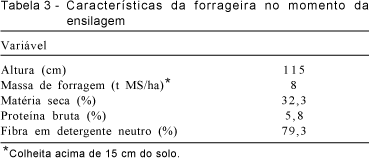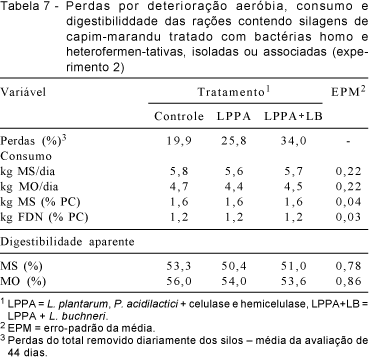Two trials were conducted to evaluate losses of Marandu grass silages using different additives. The fermentation profile and aerobic stability of the silages were evaluated on the first trial. The followings silages were evaluated: 1 - Marandu grass (Control), 2 - Marandu grass plus L. plantarum and Propionibacterium, 3 - Marandu grass plus L. buchneri, 4 - Marandu grass plus 0.1% of sodium benzoate. On the second experiment, it was utilized nine castrated Nellore steers (Body weight 350 ± 38.9 kg) allocated in three Latin squares (3 x 3) to evaluate the intake and digestibility of the total mixed rations containing 85% of Marandu silage. The followings silages were evaluated: 1 - Marandu grass (Control), 2 - Marandu grass plus L. plantarum, Pediococcus acidilactici associated to fibrolitic enzymes, and 3 - Marandu grass plus L. plantarum, Pediococcus acidilactici associated to fibrolitic enzymes plus L. buchneri. On the experiment 1, the silages showed lowest dry matter recovery (average 86%). The in vitro true dry matter digestibility reduced from 65.5%, before Marandu ensilage, to 50.0% after 60 days of silo closure. On the second trial, the average total mixed feed intake was 5.7 kg DM/day (1.6% of the BW), and the digestibility values (51.6%) was similar among rations. The evaluated silages showed high losses during the fermentative phase, and additive application did not change these profiles. The bacteria application didn't affect the dry matter intake of rations and digestibility values.
Brachiaria brizantha; inoculant; intake; Lactobacillus; losses









